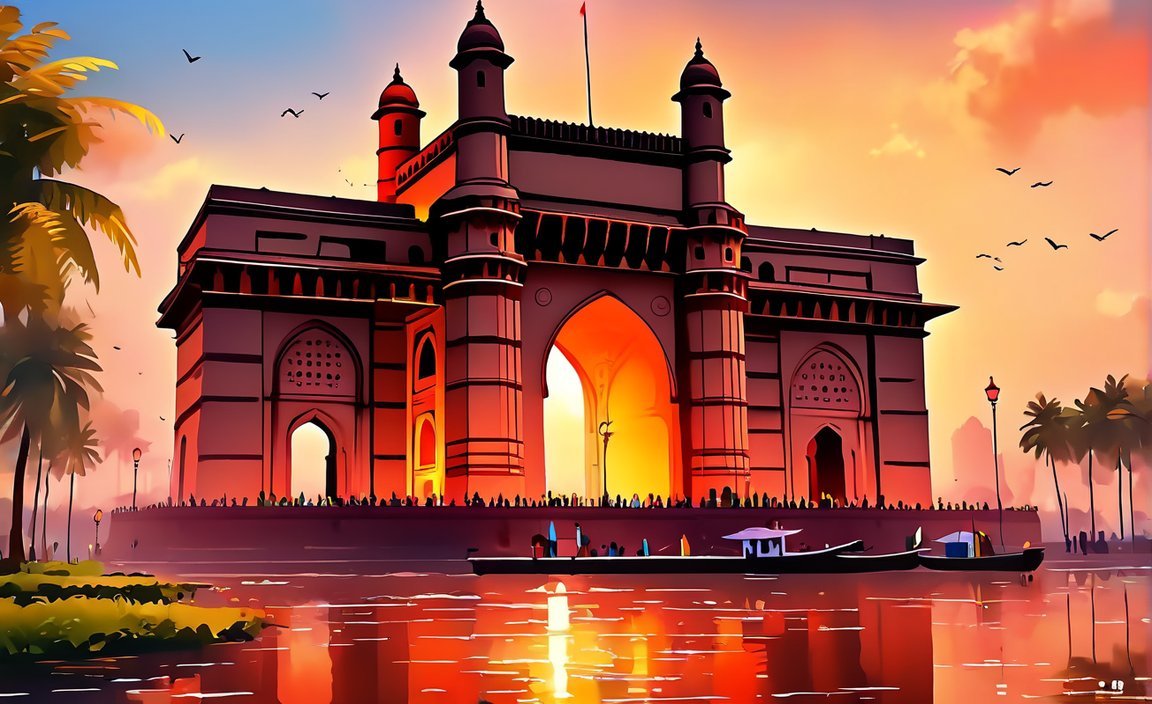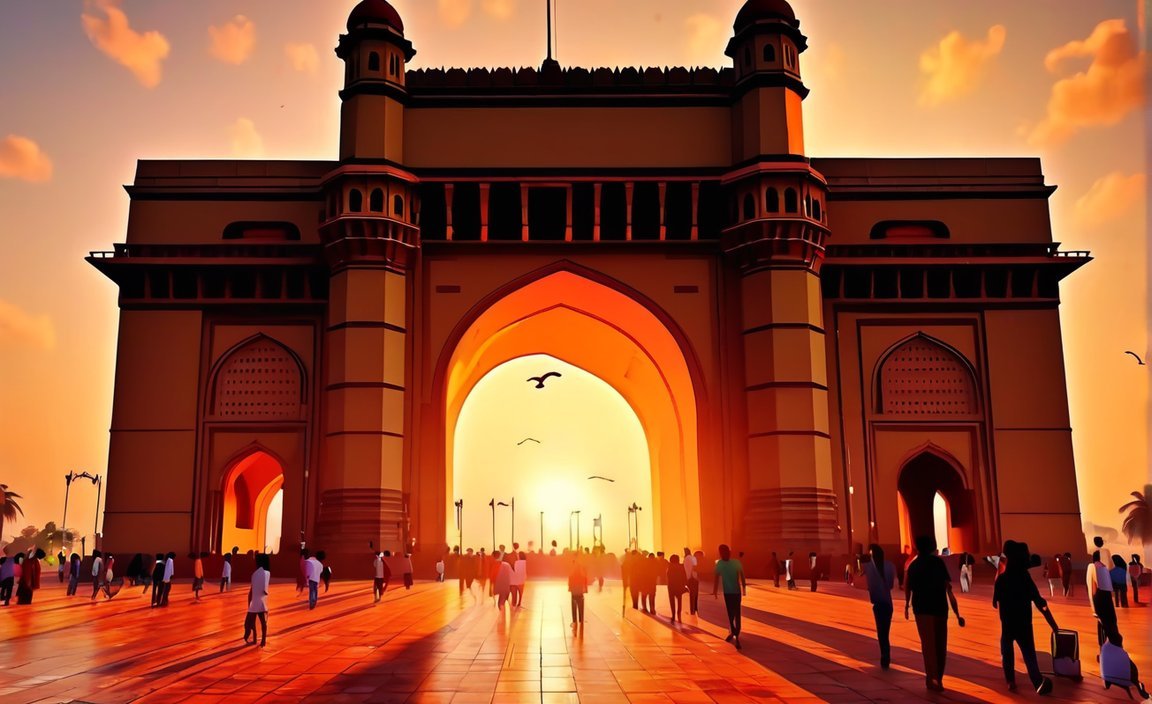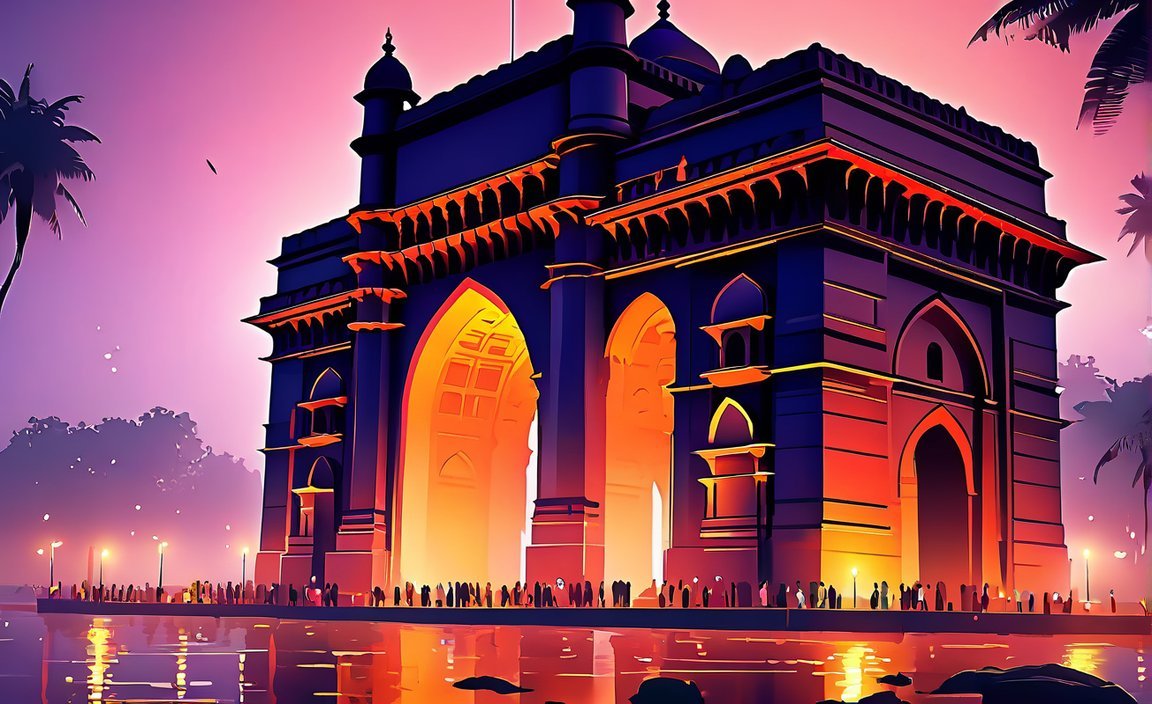Gateway of India: प्रमुख भारतीय स्मारकांच्या मराठीतील १० ओळी – Explore the rich heritage and cultural significance of India through this captivating article on the Gateway of India. Learn about its historical context, architectural beauty, and the symbolism it holds for the bustling city of Mumbai. In just 10 lines in Marathi, delve into the fascinating story of this iconic monument and be transported to a world of architectural marvels and captivating history.
Key Takeaways:
- Origin and Significance: The Gateway of India was built during the British Raj to commemorate the visit of King George V and Queen Mary to Mumbai. It represents India’s colonial past.
- Architectural Style: The Gateway of India showcases Indo-Saracenic architectural style, blending Indian and Islamic influences with intricate carvings, domes, and arched windows.
- Historical Landmark: The monument witnessed major events such as the departure of British troops after India’s independence. It has also been a venue for public gatherings and ceremonies.
- Tourist Attraction: The Gateway of India is a popular tourist spot, offering a picturesque view of the Arabian Sea. It is often crowded with visitors enjoying walks and photography.
- Iconic Hotel: The Taj Mahal Palace, a prestigious luxury hotel, is situated near the Gateway of India and holds historical significance.
- Accessibility: The Gateway of India is easily accessible by both land and sea, being a prominent landmark connected to major roads and offering boat rides from the nearby harbor.
- Cultural Importance: The monument has been featured in films, documentaries, and artistic displays, becoming a vital part of Mumbai’s cultural heritage.
- Light and Sound Show: The Gateway of India hosts an enchanting evening light and sound show that narrates its history through visual effects, storytelling, and music.
- Preservation and Restoration: Recent preservation work has been done to maintain the architectural integrity of the Gateway of India, ensuring its long-term protection.
- Symbol of Unity: The Gateway of India symbolizes unity and national pride for the people of India, representing the country’s rich history and cultural diversity.
10 Lines on Gateway of India in Marathi

The Gateway of India, also known as “भारताच्या प्रवेशद्वार,” is a magnificent historical landmark situated in मुंबई. It has immense cultural and historical significance that makes it a must-visit destination.
ओळी १: गेटवे ऑफ इंडिया म्हणजे भारतातील अत्यंत प्रमुख भावीस्थान. हे इंग्रजी साम्रज्यवादाचा प्रतीक म्हणून आपले स्थान ठेवून येणारे येथे किंग जॉर्ज व्ही आणि क्वीन मेरी यांचं भ्रमण नोंदविलं गेलं होतं.
ओळी २: इंदो-सारासेनीक वास्तुकला: गेटवे ऑफ इंडिया हा इंदो-सारासेनीक वास्तुशिल्पानुसार निर्मित आहे. इंडियन व इस्लामिक आशापाशानुसारचा वास्तूशिल्प या मोर्मालांमध्ये आहे. ह्या संगणकातील सुंदर मोहरे, गुंबांनी सळसळायलेले सज्ज, आणि वर्तनी पटावे या म्हणजेच विविध संस्कृतींच्या फ्युजनचा प्रतिमान करतात.
ओळी ३: इतिहासाचं महत्त्व: गेटवे ऑफ इंडिया भारतातील मोठं इतिहासिक महत्व धरणारं स्थान आहे. हा भव्य स्मारक म्हणजे इंपरियलिस्ट साम्रज्याच्या सुरवातचं उघडपणाची सुरुवात केलेली होती. इंडिया मधील महत्त्वाच्या घटनांचं साक्षी स्थल म्हणूनही येथे लम्हेलं आहे.
ओळी ४: प्रमुख पर्यटन स्थळ: गेटवे ऑफ इंडिया हे एक प्रसिद्ध पर्यटन स्थळ आहे. इंद्रधनुष्यसमान आकर्षणाच्या स्थानावर असलेले हे स्मारक नक्कीच पर्यटकांना आकर्षित करते. अरबी समुद्राकडे बघण्यास सुखद मार्ग म्हणूनही, हा स्थान छान फोटोग्राफीसाठी आणि आरामपूर्वक चलण्यासाठी आदर्श आहे.
ओळी ५: प्रतिष्ठान असेलेला महत्वपूर्ण हॉटेल: सानुकूल्य आणि इतिहासाचा एक महत्त्वाचा असा सानुकूल्य हॉटेल, ताज महाल पॅलेस, गेटवे ऑफ इंडियाच्या जवळ वसलेला आहे. भारतातील सर्वोत्कृष्ट आणि आपल्या वाचनांसाठी अप्रतिम ह्या संकेतस्थळाला कसा स्वागत केला जातो हे आवडतं आहे. ह्याच्या अस्तित्वाची कल्पना करता येतात विविध प्रसिद्ध व्यक्तित्वांची व्याख्या करणारे घटनांची अनेकदा आयोजित केली जाते.
ओळी ६: योग्यता: गेटवे ऑफ इंडियाची सुलभपणे जोडणे म्हणजे याच्या किनाऱ्यास आपुण धरात आणि खड्या प्रवासांसाठी आपल्याला मुंबईत ऴास्पुर्दीसाठी. पाया आणि समुद्रामार्गांसह आपण या स्मारकांच्या आकर्षणाला पाहिजे.
ओळी ७: सांस्कृतिक महत्त्व: गेटवे ऑफ इंडिया विविध चित्रपटांसाठी, प्रवाहपिसांसाठी आणि कलेची विविध ट्रायडमेअने साक्षीला केलेला आहे. हे मुंबईच्या सांस्कृतिक विरासतीचा आहे आणि प्रतिष्ठित केलेल्याप्रमाणे या नगराचे छांट त्यात व्हाया आहे.
ओळी ८: प्रकाश आणि ध्वनी प्रदर्शन: गेटवे ऑफ इंडिया संध्याकाळी मद्भाव आणि महत्त्वाची बंगारंग प्रदर्शनी होस्ट करते, ती प्रशंसायोग्य ढंबवणारी दिसते. रंग व ध्वनीदर्शकांकडूनही या संबंधाची माहिती प्राप्त करायला किंवा आपल्याला बडीलकी म्हणून घेण्यासाठी या प्रदर्शनाची आवेदन केली जाते.
ओळी ९: संरक्षण आणि पुनर्निर्माण: अंतिम काही वर्षात, गेटवे ऑफ इंडियाची पुनर्निर्मिती आणि मर्यादितत्वाची महत्त्वाची कार्ये झाली आहेत. प्रशासन आणि स्थानिक प्राधिकरणे ह्या ऐतिहासिक स्मारकाची दीर्घकालिक संरक्षण आणि निगमन खात्रीकरणाच्या उपायांनी सुनिश्चित केलं आहे.
ओळी १०: एकत्रण आणि कौटुंबिक गर्व: गेटवे ऑफ इंडिया भारताच्या लोकांसाठी एकत्रणाचं आणि राष्ट्रीय प्राइडचं एक प्रतीक म्हणून उभं आहे. हे इ.काही भारतीय इतिहास आणि सांस्कृतिक विविधतेचा साक्षी देणारं स्थान आहे आणि आपल्या पुरितयेप्रमाणे श्रद्धा आणि धन्यवाद घेण्यासाठी उत्कृष्टरीत्या सर्वजनिक हाती वायचं आहे.
अधिक माहिती साठी, आपण खालील स्रोतांच्या निर्देशिकेस दाखवू शकता:
Please check out 10 rua vasco da gama foreshore for an amazing location in Cape Town. Immerse yourself in the vibrant atmosphere of 10 rua vasco da gama plain foreshore cape town 8000.
Location and Significance of the Gateway of India in Mumbai

The Gateway of India, or भारताच्या प्रवेशद्वार in Marathi, is a mesmerizing landmark located in Mumbai. It holds immense historical and cultural significance as it welcomes visitors to the city by the Arabian Sea.
A Symbol of India’s Rich Heritage
Constructed to commemorate the historic visit of King George V and Queen Mary in December 1911, the Gateway of India stands as a symbol of India’s rich history and cultural legacy. This visit marked an important event in India’s colonial past, making the monument a testament to the influence of the British Empire.
Architectural Beauty in Fusion
The Gateway of India showcases a fusion of British and Indian architectural elements, making it a unique and remarkable structure. Constructed using yellow basalt and concrete, the monument features a rectangular shape with three arched passageways. Its Indo-Saracenic design combines intricate details from Indian and Islamic architectural styles, captivating the imagination of onlookers.
Prominent Location and Scenic Beauty
Strategically situated across from the iconic Taj Mahal Palace and Tower Hotel, the Gateway of India boasts a prime location in Mumbai. Its waterfront position provides breathtaking views of the Arabian Sea, creating a picturesque setting that fascinates both locals and tourists alike. This prominent location enhances the allure of the monument and makes it a must-visit destination for anyone exploring Mumbai.
Tourist Attraction and Cultural Heritage
The Gateway of India stands among the top tourist attractions in Mumbai. This protected monument, managed by the Archaeological Survey of India (ASI), attracts visitors from around the world. The monument’s historical and cultural significance, combined with its stunning location, offers a unique experience for travelers. Street vendors, photographers, and locals often gather at this site, adding to its vibrant atmosphere.
Witness to History and Struggles
Throughout its existence, the Gateway of India has witnessed significant events. Unfortunately, it was also the site of a terror attack on August 25, 2003. This tragic incident served as a stark reminder of the challenges faced by India in its fight against terrorism. The resilience and preservation of the monument showcase the spirit and determination of the people.
Cultural Depictions in Media
The Gateway of India has left a lasting mark on various forms of media. The monument appears in the Mumbai-based video game “Mumbai Gullies” and several films, such as “Don,” “Parinda,” and “Mr. X in Bombay.” These cultural references further emphasize the significance of the Gateway of India in popular culture.
Key Takeaways:
- The Gateway of India is a historical landmark in Mumbai that symbolizes India’s rich heritage.
- Its architectural beauty showcases a fusion of British and Indian styles.
- Situated near the Arabian Sea, the monument offers stunning views and holds a significant place in Mumbai’s landscape.
- As a popular tourist attraction, it attracts visitors from around the world.
- The Gateway of India has witnessed historical events and serves as a reminder of India’s struggles.
- Its presence in media showcases its cultural significance in popular culture.
Sources:
– Gateway of India: A Symbol of India’s Rich History
– Gateway of India: Significant Landmark in Mumbai
Cultural Importance and Its Role as a Tourist Attraction
The Gateway of India holds immense cultural importance and serves as a prominent tourist attraction in Mumbai, India. Let’s explore the historical significance, architectural beauty, and tourism aspects of this iconic monument.
History and Significance
The Gateway of India was built to commemorate the historic landing of King George V and Queen Mary in India in 1911. This visit marked an important event in India’s colonial past, as it was the first visit by a British monarch to the country. As such, the monument stands as a symbol of India’s rich history and cultural heritage.
Design and Architecture
The architecture of the Gateway of India is a blend of Indo-Saracenic, Gothic, and Islamic styles, making it a unique and remarkable structure. Constructed using yellow basalt and concrete, the monument showcases a rectangular shape with intricately designed arched passageways. Its fusion of British and Indian architectural elements is a testament to the diverse influences that have shaped India’s cultural identity.
Location and Jetties
Located at the waterfront of Mumbai and overlooking the Arabian Sea, the Gateway of India occupies a prominent spot in the city. Its picturesque surroundings and proximity to the Taj Mahal Palace and Tower Hotel make it an ideal destination for tourists. Additionally, the presence of jetties adds to the allure of this architectural marvel.
Tourism and Development
The Gateway of India is one of the top tourist attractions in Mumbai. As a protected monument under the Archaeological Survey of India (ASI), it draws both locals and tourists alike. Visitors can explore the monument, take memorable photographs, and immerse themselves in its historical and cultural significance. The vibrant atmosphere with street vendors, photographers, and locals further enhances the tourism experience.
Key Takeaways:
- The Gateway of India holds cultural significance as a symbol of India’s colonial past and cultural heritage.
- Its architecture exhibits a fusion of British and Indian styles, showcasing the diverse influences on India’s cultural identity.
- The monument’s location and proximity to the Taj Mahal Palace Hotel make it a popular tourist destination.
- It attracts a large number of visitors who come to explore its historical, architectural, and cultural significance.
- The vibrant atmosphere with street vendors and locals adds to the tourism experience.
Sources:
– English Summary – 10 Lines Essay on Gateway of India
– Culture Trip – Gateway Of India The Taj Mahal Of Mumbai
Anecdotes and Stories Related to the Gateway of India
The Gateway of India in Mumbai is not just a magnificent architectural marvel; it is also a treasure trove of fascinating anecdotes and stories that showcase its historical and cultural significance. Let’s embark on a journey through time and explore some captivating tales associated with this iconic monument.
1. The Grand Welcome
One of the most well-known anecdotes related to the Gateway of India is about its inauguration. On February 28, 1911, when King George V and Queen Mary arrived in Bombay, they were greeted with an extravagant ceremony at the Apollo Bunder. The foundation stone for the Gateway of India was laid during this event, marking the beginning of its construction.
2. The Solemn Farewell
While the Gateway of India was intended to serve as a grand entrance, it also witnessed poignant departures. After India gained independence in 1947, the last British troop to leave the country passed through the Gateway of India, symbolizing the end of the British Raj and the dawn of a new era for India.
3. A Triumph of Architecture
The striking architecture of the Gateway of India is mesmerizing in itself, but did you know that its design is emblematic of multiple influences? The monument seamlessly blends Indo-Saracenic, Gothic, and Roman architectural styles, creating a visual spectacle that represents the diverse heritage of India. This fusion of architectural elements is a testament to the creativity and craftsmanship of the architects.
4. The Regal Archway
The Gateway of India stands tall at a height of 85 feet and is adorned with intricate carvings and ornamental features. It serves as a magnificent archway, inviting visitors to explore the vibrant city of Mumbai. Its regal presence adds a touch of grandeur to the city’s skyline and serves as a reminder of its colonial past.
5. Symbol of Resilience
The Gateway of India has withstood the test of time and witnessed numerous historical events, but it also faced a tragic incident. In 2003, a bomb blast occurred near the monument, causing extensive damage. However, this incident only strengthened the resolve of the people, who worked tirelessly to restore and preserve this important cultural landmark.
6. Gateway to Bollywood
The Gateway of India has been a favorite backdrop for filmmakers in Bollywood. Numerous movies have featured this iconic monument, including popular titles like “Don,” “Parinda,” and “Mr. X in Bombay.” The presence of the Gateway of India in these films adds a touch of romance and drama, making it a beloved cinematic symbol.
7. Cultural Hub
Surrounding the Gateway of India, you will find a bustling atmosphere filled with street vendors, shops, and restaurants. This vibrant hub offers a taste of Mumbai’s local culture and provides visitors with a chance to indulge in local delicacies and shop for souvenirs. It’s the perfect place to immerse yourself in the sights, sounds, and flavors of the city.
8. Spectacle of Lights
In the evenings, the Gateway of India becomes even more enchanting as it lights up with a colorful display. The monument hosts mesmerizing light and sound shows that captivate the audience and transport them to a bygone era. It’s an immersive experience that brings the history and allure of the Gateway of India to life.
As we conclude our journey through the anecdotes and stories related to the Gateway of India, it’s clear that this majestic monument is not just a structure of stone and concrete. It is a symbol of Mumbai’s rich history, cultural heritage, and resilience. The Gateway of India invites us to delve into its tales and appreciate the beauty and significance it holds for the city and its people.
Key Takeaways:
– The inauguration of the Gateway of India marked the grand welcome of King George V and Queen Mary to Bombay (Mumbai).
– It served as a solemn farewell point for departing British troops after India gained independence.
– The Gateway of India showcases a fusion of Indo-Saracenic, Gothic, and Roman architectural styles, making it a triumph of design.
– Despite facing a tragic incident in 2003, the monument stands as a symbol of resilience and restoration.
– Bollywood movies have frequently featured the Gateway of India, adding to its cultural significance.
– The bustling atmosphere around the monument offers a glimpse into Mumbai’s local culture and cuisine.
– The Gateway of India lights up in a mesmerizing spectacle of colors, creating a magical experience for visitors.
Sources:
– Culture Trip – Gateway Of India The Taj Mahal Of Mumbai
– English Summary – 10 Lines Essay on Gateway of India
FAQ
Q1: गेटवे ऑफ इंडिया म्हणजे काय?
A1: गेटवे ऑफ इंडिया हा भारतातील एक प्रमुख स्मारक आहे. हे मुंबईच्या एका वॉटरफ्रंटवर स्थित असते आणि १९११ मध्ये भारताला येणाऱ्या अंग्रेज राज्याची सुरुवात बोलतो.
Q2: गेटवे ऑफ इंडियाचा इतिहास काय आहे?
A2: गेटवे ऑफ इंडियाचा इतिहास निरंतर अंगीकारांकीत आहे. हे १९११ मध्ये गॅलर्ड ईर्विनच्या कार्यकारीणीच्या करारानुसार निर्मित केले गेले. हे द किंग चर्च च्या ग्रुप वाचवण्यासाठी केले गेले बोलतो.
Q3: गेटवे ऑफ इंडियाची वास्तुशिल्प केमिकले आहे?
A3: गेटवे ऑफ इंडिया म्हणजे खाकी बसालट आणि प्रगमात्मक ठोसपट, ज्यामुळे ती भारतीय आणि इस्लामिक वास्तुशिल्पाची संयोजन परिष्कृत केली आहे. ही आपल्या आकारातील ग्रंथकार्यांची चमकदार विचारधातूमय दाखविते.
Q4: गेटवे ऑफ इंडिया म्हणजे किती दूर?
A4: गेटवे ऑफ इंडिया मुंबईच्या वोहालिचंदीच्या किणारावर असतो. आपल्याला ८ सुतारपाचे लांब किणार्यांपासून पास जायला लागेल.
Q5: गेटवे ऑफ इंडिया हा महत्त्वाचा स्मारक आहे का?
A5: होय, गेटवे ऑफ इंडिया महाराष्ट्रातील महन ऐतिहासिक स्मारकांपैकी एक आहे. हे म्हणजे महाराष्ट्रात सर्वाधिक महत्त्वाची भिंती आहे.












